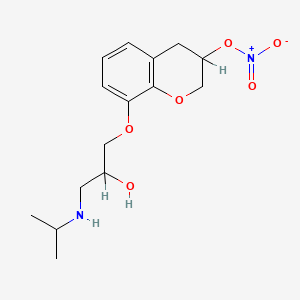



1. 3,4-dihydro-8-(2-hydroxy-3--isopropylaminopropoxy)-3-nitroxy-2h-1-benzopyran
2. K 351
3. K-351
1. Nipradolol
2. 81486-22-8
3. Hypadil
4. Hypadil (tn)
5. K 351
6. Fvm336i71y
7. 8-(2-hydroxy-3-(isopropylamino)propoxy)chroman-3-yl Nitrate
8. 8-(2-hydroxy-3-(isopropylamino)propoxy)-3-chromanol, 3-nitrate
9. [8-[2-hydroxy-3-(propan-2-ylamino)propoxy]-3,4-dihydro-2h-chromen-3-yl] Nitrate
10. Hypadil; K 351; Kt 210; Nipradilo
11. Nipradilolum [latin]
12. Nipradilolum
13. Nipradilol [inn:jan]
14. Ccris 2515
15. Brn 3566879
16. Unii-fvm336i71y
17. Nipranol
18. 8-(2-hydroxy-3-(isopropylamino)propoxy)-3-chromanyl Nitrat
19. Nipradilol [mi]
20. 8-(2-hydroxy-3-(isopropylamino)propoxy)-3-chromanol 3-nitrate
21. Nipradilol (jan/inn)
22. Nipradilol [inn]
23. Nipradilol [jan]
24. Nipradilol [inci]
25. K-351
26. 3,4-dihydro-8-(2-hydroxy-3-isopropylamino)propoxy-3-nitroxy-2h-1-benzopyran
27. Nipradilol [mart.]
28. 3,4-dihydro-8-(2-hydroxy-3-((1-methylethyl)amino)propoxy)-2h-1-benzopyran-3-ol 3-nitrate
29. 3,4-dihydro-8-(2-hydroxy-3-(isopropylamino)propoxy)-2h-1-benzopyran-3-ol 3-nitrate
30. Nipradolol [who-dd]
31. Schembl48884
32. Chembl155622
33. Chebi:31682
34. Dtxsid30868615
35. Bcp04466
36. Kt-210
37. Akos016014067
38. 2h-1-benzopyran-3-ol, 3,4-dihydro-8-(2-hydroxy-3-((1-methylethyl)amino)propoxy)-, 3-nitrate
39. Ft-0630894
40. D01691
41. L013397
42. Q15634005
43. 3,4-dihydro-8-(2-hydroxy-3-isopropylaminopropoxy)-3-nitroxy-2h-1-benzopyran
44. 3-nitroxy-8-[(2-hydroxy-3-isopropylamino)propoxy]-3,4(2h)-dihydro-1-benzopyran
45. 8-[2-hydroxy-3-(isopropylamino)propoxy]-3,4-dihydro-2h-chromen-3-yl Nitrate #
46. 8-{2-hydroxy-3-[(propan-2-yl)amino]propoxy}-3,4-dihydro-2h-1-benzopyran-3-yl Nitrate
| Molecular Weight | 326.34 g/mol |
|---|---|
| Molecular Formula | C15H22N2O6 |
| XLogP3 | 2 |
| Hydrogen Bond Donor Count | 2 |
| Hydrogen Bond Acceptor Count | 7 |
| Rotatable Bond Count | 7 |
| Exact Mass | 326.14778643 g/mol |
| Monoisotopic Mass | 326.14778643 g/mol |
| Topological Polar Surface Area | 106 Ų |
| Heavy Atom Count | 23 |
| Formal Charge | 0 |
| Complexity | 376 |
| Isotope Atom Count | 0 |
| Defined Atom Stereocenter Count | 0 |
| Undefined Atom Stereocenter Count | 2 |
| Defined Bond Stereocenter Count | 0 |
| Undefined Bond Stereocenter Count | 0 |
| Covalently Bonded Unit Count | 1 |
Antihypertensive Agents
Drugs used in the treatment of acute or chronic vascular HYPERTENSION regardless of pharmacological mechanism. Among the antihypertensive agents are DIURETICS; (especially DIURETICS, THIAZIDE); ADRENERGIC BETA-ANTAGONISTS; ADRENERGIC ALPHA-ANTAGONISTS; ANGIOTENSIN-CONVERTING ENZYME INHIBITORS; CALCIUM CHANNEL BLOCKERS; GANGLIONIC BLOCKERS; and VASODILATOR AGENTS. (See all compounds classified as Antihypertensive Agents.)
Vasodilator Agents
Drugs used to cause dilation of the blood vessels. (See all compounds classified as Vasodilator Agents.)
Adrenergic alpha-Antagonists
Drugs that bind to but do not activate alpha-adrenergic receptors thereby blocking the actions of endogenous or exogenous adrenergic agonists. Adrenergic alpha-antagonists are used in the treatment of hypertension, vasospasm, peripheral vascular disease, shock, and pheochromocytoma. (See all compounds classified as Adrenergic alpha-Antagonists.)
Adrenergic beta-Antagonists
Drugs that bind to but do not activate beta-adrenergic receptors thereby blocking the actions of beta-adrenergic agonists. Adrenergic beta-antagonists are used for treatment of hypertension, cardiac arrhythmias, angina pectoris, glaucoma, migraine headaches, and anxiety. (See all compounds classified as Adrenergic beta-Antagonists.)